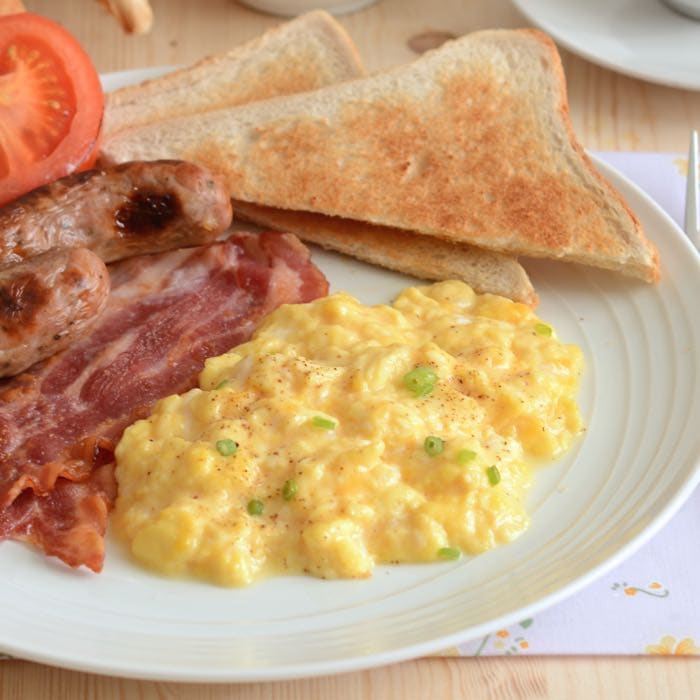Get perfect soft and creamy scrambled eggs every time with this really simple recipe.
In my life I’ve eaten a lot of bad scrambled eggs, either too dry or soft but watery. In fact for a long time I thought I didn’t really like scrambled eggs, much preferring poached or fried. It turns out they’re actually my favourite (although I’m quite fickle when it comes to food so don’t hold it against me if I change my mind later!).
In my opinion, perfect scrambled eggs are soft and creamy. I use both butter and milk in mine, which add to the creamy texture and flavour (unfortunately it also adds to the calories so they’re more of a treat that I eat less often than my poached or fried eggs).
So what’s the secret to perfect scrambled eggs?
Patience
It’s an incredibly frustrating thing to cook. You need to cook it on a very low heat. At first it looks like it’s not doing anything, your hand will be hovering over the heat control on the hob tempted to crank it up a bit. DON’T! Just remember dry or soggy (or possibly both!) and take your hand away.
It will cook, just give it time.
If you give in to temptation and cook your scrambled eggs on too high a heat, you’ll either over-cook them giving you the dry version, or you’ll think they look perfect and then by the time you’ve got to the table they’re sitting in a pool of water (or worse, you’ve put them on toast and your toast is all nasty and soggy).
The right mix of milk and eggs
I like to make scrambled eggs using full fat milk. I know some recipes use cream, I don’t quite simply because it’s not something I usually have in the fridge, whereas I’ve always got milk.
There are also some recipes that suggest using just eggs and butter and skipping the milk. Personally I think doing it this way means it lacks a certain creaminess that makes it taste delicious (without milk it tastes like an omelette that’s fallen apart). I also find that using milk makes it a little more forgiving when you cook it. Without milk, it can quickly form a rubbery skin which isn’t pleasant to eat.
However, you don’t want to overdo the milk as the more liquid you add the more likely it is to be watery and the longer it’ll take to cook. I’ve found the perfect ratio to be 30ml of milk for each egg.
Multiplying the recipe
This recipe can be easily multiplied to make as much as you need. However, be warned that the more you attempt to cook in one pan the longer it’ll take (I once attempted a batch that took 50 minutes!).
If you’re making scrambled eggs for quite a few people it’ll probably be quicker to use several pans.
FREE GRAMS TO CUPS CONVERSION CHARTS

Subscribe to the Charlotte's Lively Kitchen mailing list to get your FREE printable grams to cups and cups to grams conversion charts for twelve popular baking ingredients

Scrambled Eggs
INGREDIENTS
- 2 eggs
- 60 ml full fat milk
- 1 tsp butter
- salt and pepper
INSTRUCTIONS
- Beat the eggs (2 eggs) and milk (60ml) and season with salt and pepper.
- Melt the butter in a small frying pan on the lowest possible heat setting on your hob.
- Once the butter has melted, add the eggs and milk.
- Leave to cook (don't stir) for about 30 seconds. Then using a large spoon or fish slice scrape down the sides of the pan towards the centre. Repeat every 30 seconds (ish) until you start to see solid lumps appearing in the centre after you've scraped.
- Once the lumps have started appearing the egg will start to cook more rapidly so start scraping from the sides to the centre about every 10 seconds until the egg is almost set - it will continue to cook in it's residual heat.
- Serve.
NOTES
NUTRITIONAL INFORMATION
Any nutritional information provided is the estimated nutritional information per serving. Please refer to my guide to Charlotte’s Lively Kitchen nutritional information if you would like to learn more about how this is calculated.
Free From/Suitable For…
The ingredients I used to make this recipe are all free from the following allergens. However, please check any labels carefully for allergens you need to avoid as brands can vary and product recipes can change over time.
- Suitable for Vegetarians
- Gluten-Free
- Tree Nut-Free
- Peanut-Free
- Sesame-Free
- Soya-Free
- Sulphur Dioxide & Sulphite-Free
- Fish-Free
- Crustacean-Free
- Mollusc-Free
- Celery-Free
- Mustard-Free
- Lupin-Free





Helen says
My secret to scrambled eggs is LOADS of butter. But, ahem, yes that would increase the calories somewhat… 🙂 Helen
Charlotte Oates says
Sounds yummy!
Dave says
I’ll certainly be trying this! I’m eating lots of eggs atm ‘cos I’m being a good boy and hitting the gym – and need all the protein I can get. My scrambled eggs are indeed often too watery…so thanks! I’ll let you know how they go 🙂
Charlotte Oates says
If you’re going for the heathy option then you should stick with poached or heathy fried, there’s far too much butter and full fat milk in scrambled (I’ve tried cutting them back and it doesn’t taste right).
Me says
One word: yummy! Great tips here. I had no idea about the low heat thing. So it is too much heat too quickly that makes omelettes / quiches watery? I learnt something today 🙂
Charlotte Oates says
I’ve no idea with quiche as I don’t make it that often but it would make sense as it has very similar ingredients. I’ll have to test it out sometime.